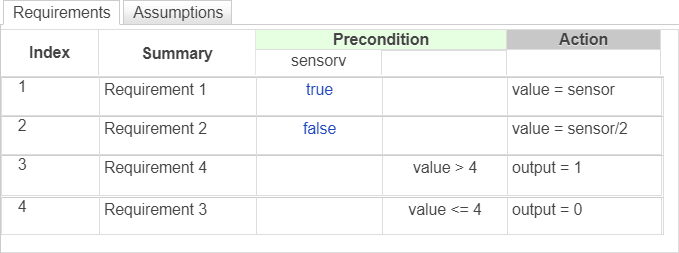利用形式需求的评估顺序
自 R2022a 起
Requirements Table 模块从第一个需求开始向下评估需求。您可以通过为数据分配值,然后在需求集稍后列出的需求中使用数据来利用此行为。
例如,如果您想在其他需求的预条件中引用本地数据:
列出集合中首先定义本地数据值的需求。
稍后列出预条件中需要本地数据的需求。
验证您的需求在写入之前不会读取数据。
如果您有 Simulink® Design Verifier™,您可以分析需求来检测在写入数据之前读取数据的实例。在表选项卡的分析部分中,点击分析表。请参阅检测先读后写问题。
有关如何定义需求的更多信息,请参阅 使用 Requirements Table 模块创建正式需求。
如果在预条件中启用输出属性已启用,或者数据是 getPrevious 运算符的参量,则可以在前提条件中引用输出数据。要启用此属性,请打开 Requirements Table 模块。在建模选项卡的设计数据部分中,点击属性检查器。在属性选项卡中,启用在预条件中启用输出属性。请参阅在预条件中启用输出。
使用需求顺序的示例
此示例显示了需求顺序如何影响 Requirements Table 模块中的数据。

检查需求
打开 Requirements Table 模块。该模块使用输入数据 sensorv 和 sensor 来确定本地数据 value 的值。然后需求使用 value 来确定输出数据 output 的值。

如果在需求 1 和 2 之前定义需求 3 和 4,则需求在需要 value 之前不会定义 value,这会在仿真期间导致先读后写错误。